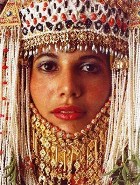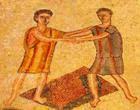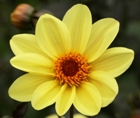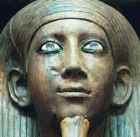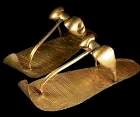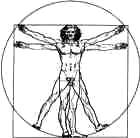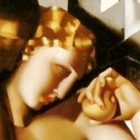Clothes for rich & poor
Clothes for rich people
There are no pictures of rich (or poor) people in ancient Israel – Jewish religion forbade images of any kind. But rich Jewish people copied the clothing of the fashionable world outside Israel, so we can guess what they wore.
Then as now, clothes – the right sort – let rich people show they were wealthy.
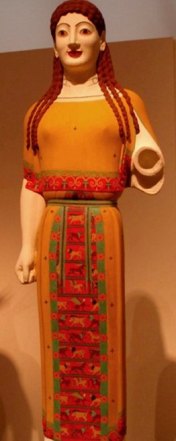
Reconstruction of the Peplos Kore as the goddess Artemis
Rich people had
- clothes for winter and for summer
- clothes for going out and staying at home, or for work and leisure
- and clothes of different materials – fine linen, fine wool, or sometimes in the later period silk.
Women’s clothing was of course the most richly decorated. The peplos kore at right gives us some idea of the ornate embroidery and fine fabric that might be worn by a rich Athenian woman.
Intricate embroidery was one one of showing status in the ancient world, since it required not only the purchase of rich thread and fabric, but payment to highly skilled embroiderers. Since Athens was quite close geographically to Israel, we can assume that the fabrics and designs used there would have influenced fashion in Israel.
The people of ancient Israel also copied fashions in Egypt, Assyria or later on, Rome. These countries exported luxury goods, and then as now people with enough money were prepared to pay large amounts for items in the latest fashion.
What were the fashions?
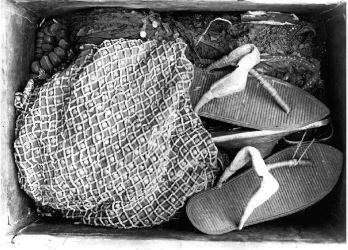
Box containing garments and shoes
from the tomb of Tutankhamun
The clothing itself is long gone, but statues and murals give us some idea of the luxury items worn by men and women. Some 50 garments or items of clothing were found in Tutankhamun’s tomb. This included a heavily beaded garment (see at right), tunics, kilts, gloves, scarves, pairs of sandals, and headdresses.
Unfortunately, due to their great age, the clothes disintegrated as soon as they were touched, but archaeologists were still able to tell that they had been made of the finest leather, linen and papyrus.
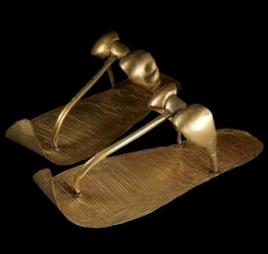
Reproduction of luxury sandals from Egypt, copied from the tomb goods of Tutankhamun; they have a reed sole
The right footwear was also important, though apparently not appreciated by everyone: the prophet Isaiah complained about rich women whose shoes made a tinkling noise when they walked, presumably because they had tiny bells attached to them (Isaiah 3:16).
The sandals below are reproductions of ones found in the tomb of Tutankhamun; they have soles made of fine reeding.
Out of doors, a rich man would wear a light coat over his tunic. This came down to his knees and was often gaily striped or woven in check patterns.
Rich people wore lightweight coats indoors as well, perhaps made from silk.
Clothes for ordinary women
Most peoples’ clothes were homespun, loose fitting, in one of the soft colors of natural dyes – a dark red, brown or yellow. The fabric was made more attractive by weaving colored stripes into it.
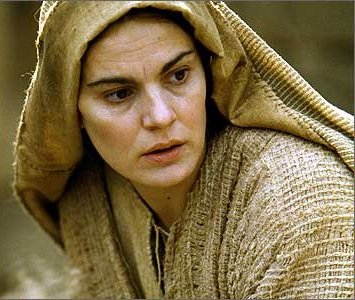
Movie still from the film ‘Passion of the Christ’, Mary in simple peasant clothes
It is possible that, as in other parts of the world, each village or local area had a distinctive pattern of stripes that identified the origin of its wearer.
Women’s undergarments were made from a length of cloth wound around her waist and looped under her groin, then tucked in at the back.
During her menstrual period she tied a long thin strip of fabric around her waist then attached a towel to soak up the menstrual blood. It was clumsy but effective, especially since she was not allowed to do any heavy work during the seven days of her cycle, but was encouraged by religious law to rest.
There has been criticism of the restrictions placed on women by the ‘purity laws’, but they seem to have worked to women’s advantage in this case at least.
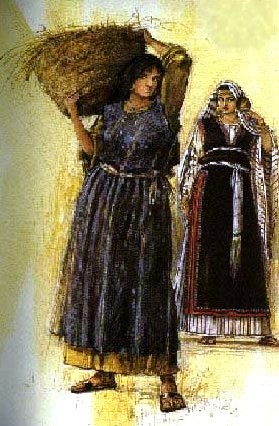
Drawing of two women in clothing from the 1st century AD, roughly the time that Jesus of Nazareth lived
The fabric used in ordinary people’s clothes was a rough weave of woollen fibre (see above Mary’s robe from the film ‘The Passion of the Christ’. The fibre, weave and design were utilitarian: women had to work hard, and they had to be comfortable while they worked.
A woman also had to have several changes of clothing, to comply with the ‘purity laws’.
If they were able, women had two types of clothing:
- a day-to-day outfit and
- something more elaborate for festivals and special occasions.
Her work-a-day tunic was pulled in with a leather or fabric belt and came down to her ankles but could be tucked up if needed.
Her festival clothing was often embroidered on the yoke, skirt or sleeves with a pattern used by all the women of her village.
Apart from this, her tunic would be very similar to a man’s. A woman could lift up the hem of her long dress and use it as a large bag, or tuck it up like an apron.
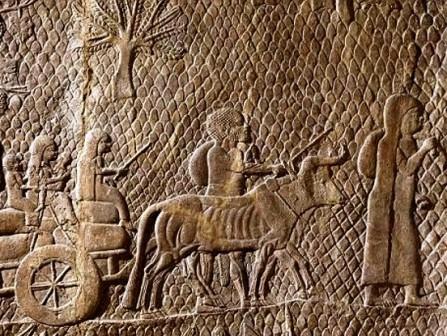
Above: in this wall relief from Nineveh the people of Lachish in Israel are being driven into exile. The women wear a long head covering reaching to the ground, which could be used as a blanket at night.
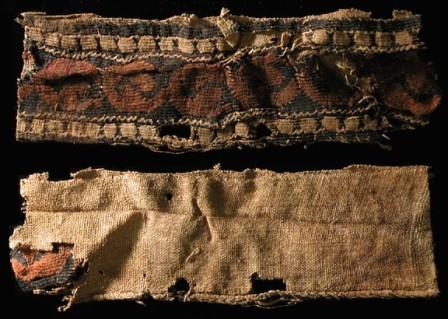
The most common colors were variants of those produced by natural dyes, as in this remnant of woven cloth from the Coptic community in Egypt (above)
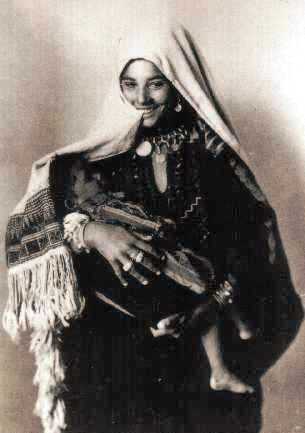
(Above & below) 19th century photographs of Arab women in embroidered and tasselled clothing.
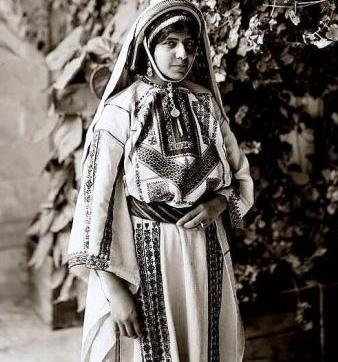
Clothes for working men
The first thing a man put on was either a loincloth or a short skirt from waist to knee. This was all he wore when he was doing heavy work.
Over the top of this came a shirt or tunic – a long piece of material folded at the centre and sewn up the sides, with armholes and an opening for the head to go through.
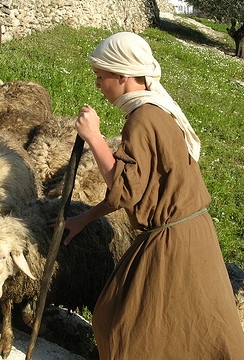
Shepherd in rough woven garment, reproduction
The tunic was fastened round the waist with a girdle or belt. This was a piece of cloth, folded into a long strip to make a kind of pocket to hold coins and other belongings.
The modern re-creation of ancient clothing at right makes the mistake of putting the shepherd in a long robe. In fact shepherds had to move quickly, to run fast, so their robes were probably only knee-length, or worn tucked up into their belt.
Both sexes wore leather ankle-length boots in winter and sandals in summer. Sandals were cut to a simple design: a piece of hide the same size as the foot, with a long leather strap which passed between the big and second toe, and was then tied round the ankle.
When a man needed to be able to move more freely, he would tuck his tunic into his belt to make it shorter – ‘girding up the loins’.
The average working villager had a change of fresh clothes, necessary if they were to keep the ritual purity laws.
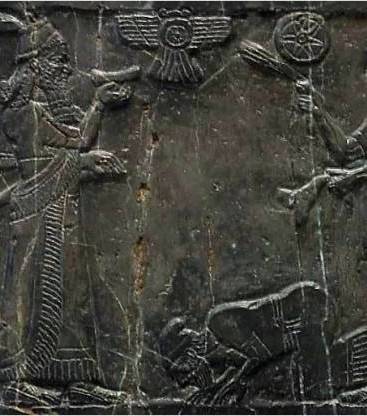
Jehu submitting to Shalmanaser III
In Israel the sun was so hot that some covering was needed to protect the head, neck and eyes. This was usually a square of cloth folded diagonally, with the fold across the forehead. A circle of plaited wool held it in place over the head, and the folds protected the neck.
A cap was sometimes worn (see Jehu’s head covering on the Black Obelisk at right), or a fine wool shawl or tallith, especially during prayer.
There was also a thick woollen coat or cloak to keep out the cold, called a himation in New Testament times. This was made from two pieces of material, often in stripes of light and dark brown, stitched together. The joined material was wrapped round the body, sewn at the shoulders, and slits were then made in the side for the arms to go through.
A poor man’s cloak was so important to him that if it was handed over to guarantee repayment of a debt, it had to be returned to him at sunset.
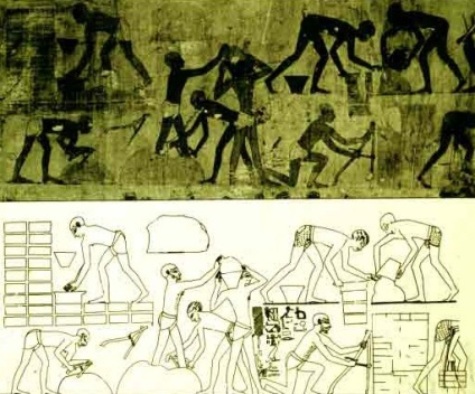
Workers performing heavy manual work often wore as little as decently possible. Copy of a wall painting showing Semitic laborers in Egypt.
Clothes in the Roman period
The garments worn by Jewish and Christian people of this period were fairly similar to those worn along the whole Mediterranean coast. However, traditional Jewish families still kept the Mosaic Law which forbade mixing wool and linen in the same garment.
Basic clothing was a tunic made from two lengths of woollen material joined at the top, with an opening for the head to pass through. It might have vertical stripes and be dyed red, cream/brown or black.
A mantle/cloak made of wool was also worn; this was woven in one single piece of cloth. There was also a woollen or linen head-covering with a band that held it in place
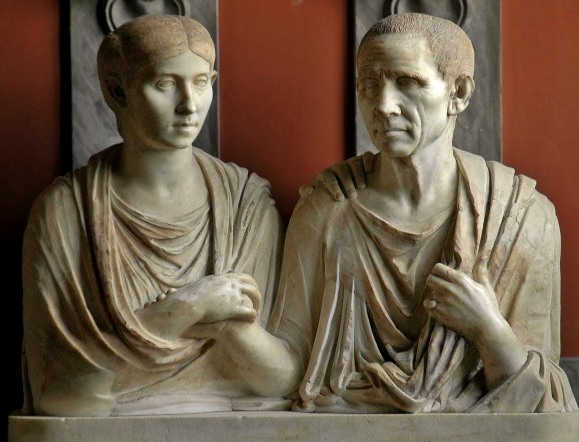
This dual funeral portrait of Gratidia and Gratidius Libanus, 1st century Romans, shows the restrained dress favored by aristocratic Romans of this period. Middle Eastern upper classes, both men and women were more lavish in their dress, and had a reputation for luxury and ostentation.
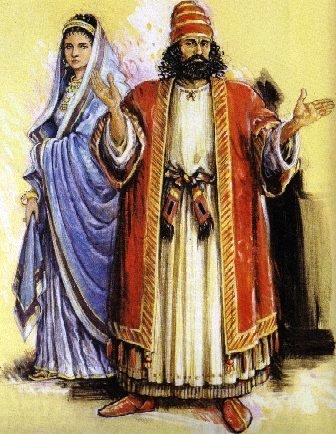
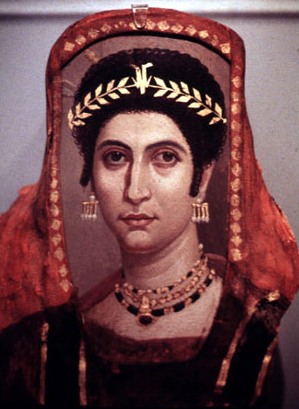
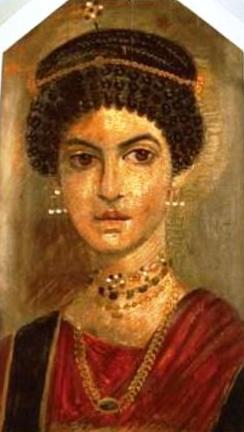
(Above) Two of the Fayum coffin portraits showing clothes and jewelry of 1st-2nd century AD upper-class women
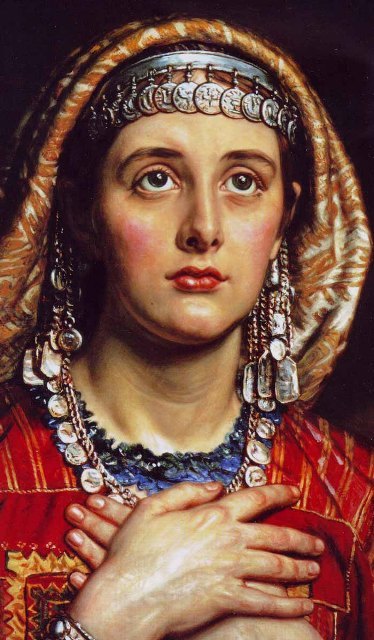
The Bride of Bethlehem, by William Holman Hunt. This idealized painting of Mary of Nazareth shows how young women displayed their dowry to prospective husbands – as an item of jewelry.
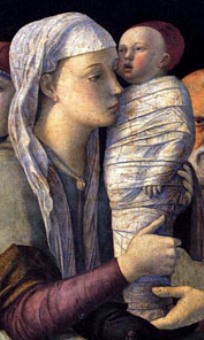 Babies’ clothing as we know it did not exist. The only unique piece of clothing was the swaddling bands wound around the baby soon after birth. These held the baby securely and warmly, duplicating the position it had when still in the womb.
Babies’ clothing as we know it did not exist. The only unique piece of clothing was the swaddling bands wound around the baby soon after birth. These held the baby securely and warmly, duplicating the position it had when still in the womb.
See Children & baby clothes for more about this.
BIBLE REFERENCES
- Mixed materials in one piece of clothing forbidden, Deut. 22:11.
- Men forbidden to wear women’s clothes, women forbidden to wear men’s clothes, Deut. 22:5.
- Rules with respect to women’s clothes, 1 Tim. 2:9,10; 1 Pet. 3:3.
- Not to be held over night as a pledge for debt, Ex. 22:26.
- Ceremonial purification of, Lev. 11:32; 13:47-59; Num. 31:20.
- Various articles of clothing: Mantle, Ezra 9:3; 1 Kin. 19:13; 1 Chr. 15:27; Job 1:20; many colored, 2 Sam. 13:18; purple, John 19:2,5. Robe, Ex. 28:4; 1 Sam. 18:4. Shawls, Isa. 3:22, Embroidered coat, Ex. 28:4,40; 1 Sam. 2:19; Dan. 3:21. Sleeveless shirt, Matt. 5:40; Luke 6:29; John 19:23; Acts 9:39. Cloak, 2 Tim. 4:13; John 19:2,5. Skirts, Ezek. 5:3. Mufflers, Isa. 3:19. Sashes, Isa. 3:20.
- Changes of raiment, the folly of excess, Job 27:16.
- Uniform vestments kept in store for worshipers of Baal, 2 Kin. 10:22,23; Zeph. 1:8; for wedding feasts, Matt. 22:11.
- Presents made of changes of clothes, Gen. 45:22; 1 Sam. 18:4; 2 Kin. 5:5; Esth. 6:8; Dan. 5:7.
Search Box
![]()
© Copyright 2006
Elizabeth Fletcher


